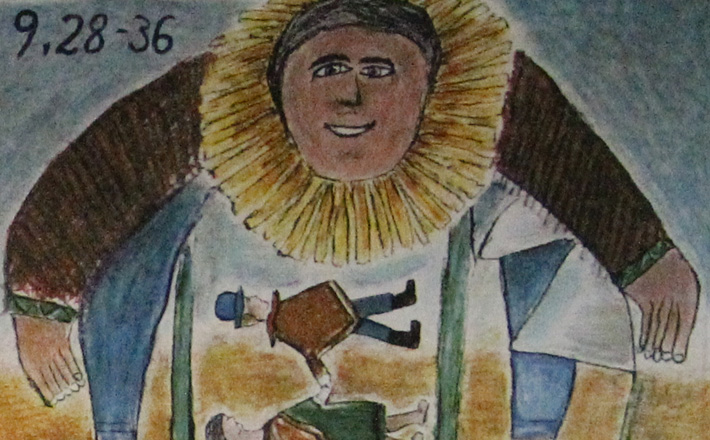Commentary on Luke 9:28-36 [37-43]
The transfiguration of Jesus follows immediately on the scene where Peter confesses Jesus to be the Christ, the Messiah (Luke 9:20).
That scene ends with Jesus’ teaching on the coming glory of God’s kingdom to be experienced by the disciples (9:26-27). The transfiguration scene provides a dramatic confirmation of Peter’s confession and a foretaste of the glory to be experienced when God’s kingdom is fully present.
Jesus’ Identity and Glory
The emphasis throughout the episode is on the dazzling attestation of Jesus’ identity. We are first given the description of his transformed appearance (verse 29). The change in the appearance of his face is reminiscent of Moses’ face becoming radiant upon experiencing the presence of God in Exodus 34:29-35. But the description of the change in Jesus’ clothes distinguishes him from Moses significantly: Jesus’ clothes become “dazzling white,” words Luke uses to describe the appearance of angelic figures in Luke 24:4 and Acts 1:10. Jesus’ transformed appearance is thus not merely because he is experiencing God’s glory (like Moses) but rather because he is the very source of divine glory. The point is made explicit when the three disciples are said to see Jesus’ glory in verse 32.
Jesus, Moses, and Elijah
The appearance of Moses and Elijah in verse 30 adds to the attestation of Jesus’ identity. The two are commonly interpreted as embodying “the Law and the Prophets,” which is no doubt a significant point. The risen Jesus himself will later assert that Moses and the prophets point toward him (Luke 24:25-27, 44-46). Luke tells us in our scene that Moses and Elijah “were speaking of his departure, which he was about to accomplish at Jerusalem” (verse 31), surely meant to anticipate Jesus’ teaching that he is the ultimate fulfillment of scripture.
Yet this is not the only significance of Moses and Elijah. That Jesus was the “prophet like Moses” predicted by Moses himself is emphasized throughout Luke and Acts (seen most clearly in Acts 3:22-23, interpreting Deuteronomy 18:15). And Elijah’s appearance was associated with the coming of the day of the Lord (Malachi 4:5). Their appearance thus points to Jesus fulfilling specific prophecies associated with them as well as the more general notion of Jesus as the fulfillment of all of scripture.
The Voice and Presence of God
The most dramatic attestation of Jesus’ identity comes with the voice of God in verse 35. The basic message echoes the divine words spoken at Jesus’ baptism (3:22), but there are notable differences:
- The message at Jesus’ baptism was spoken directly to Jesus (“You are my son”), but here the message is for the disciples’ ears (“This is my son”).
- At the baptism the adjective describing Jesus’ sonship was “beloved” — again, a message directed at Jesus — but here it is “chosen,” further describing Jesus’ relationship to God from the disciples’ perspective.
- The message of Jesus’ sonship here is given an imperative implication: “Listen to him!” Jesus’ sonship is not a matter of abstract theology but requires the obedient response of the disciples to Jesus’ message. Jesus’ most recent teaching emphasized the costly demands made on those who would follow him, i.e. denying themselves and taking up their cross (verse 23), and that is surely the primary message meant to be listened to and obeyed here.
- Whereas the voice at the baptism came “from heaven,” here it comes from the very cloud in which the disciples are already enveloped. This suggests a rather intense experience of God’s close presence! It also is again reminiscent of Moses’ own experience of God’s presence at Sinai (see Exodus 24:15-18), the most formative revelation of God in the history of Israel.
The Experience of God in Prayer
One of the significant details of the story that is unique to Luke’s account of the transfiguration is that it occurs in the context of prayer. Neither Matthew nor Mark mentions that Jesus had gone up on the mountain specifically to pray (verse 28), and neither mentions that Jesus was praying when the transfiguration occurs (verse 29). It is clearly a point that Luke wants us to note.
Prayer is, in fact, a significant theme throughout Luke’s writings. Luke is the only Gospel author to tell us of Jesus praying on other momentous occasions, too:
- Following his baptism, the Holy Spirit descends on Jesus while he his praying (3:21-22);
- Jesus’ selection of the twelve apostles occurs after spending an entire night in prayer (6:12-16);
- Peter’s confession of Jesus as the Messiah occurs in the context of Jesus’ praying (9:18-20).
Other key places where Luke shows Jesus praying include in the garden before his arrest (22:39-46) and on the cross (23:34, 46).
A point that we may especially observe in the transfiguration account, but which is also present in some of these other places, is that prayer for Jesus involved, at times, a dramatic encounter of God’s presence. Prayer was not merely speaking words to God but was a truly spiritual experience of God. Lest we think that such a possibility of divine encounter is limited to Jesus, we see the same thing with a variety of characters in Acts, Luke’s second volume. To give just a few of many examples:
- The gathered early church experienced a dramatic divine response to their communal prayer (4:23-31).
- The centurion Cornelius’s prayers result in an angel being sent to him and in him being chosen by God as the first Gentile Christian (10:1-8).
- Paul and Silas are freed from prison by God while praying (16:25-34).
- Paul experiences an encounter with the risen Christ while praying (22:17-21).
Thus while we should no doubt not expect to have experiences like that of Jesus in the transfiguration on a regular basis in prayer, the transfiguration along with these other scenes should challenge us to seek something higher in prayer than speaking mere words in the hope that God might possibly somehow listen to us. Prayer should be seeking the powerful presence of God in our lives. We must also remember, with the disciples in this scene, that dramatic experiences of Christ’s glory come with the call to listen and follow in costly obedience.


February 10, 2013